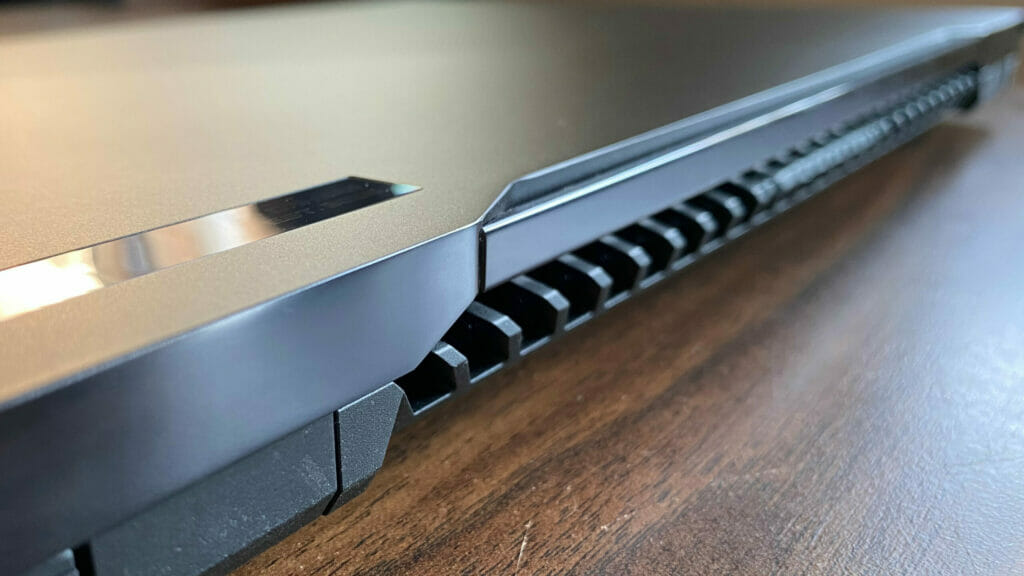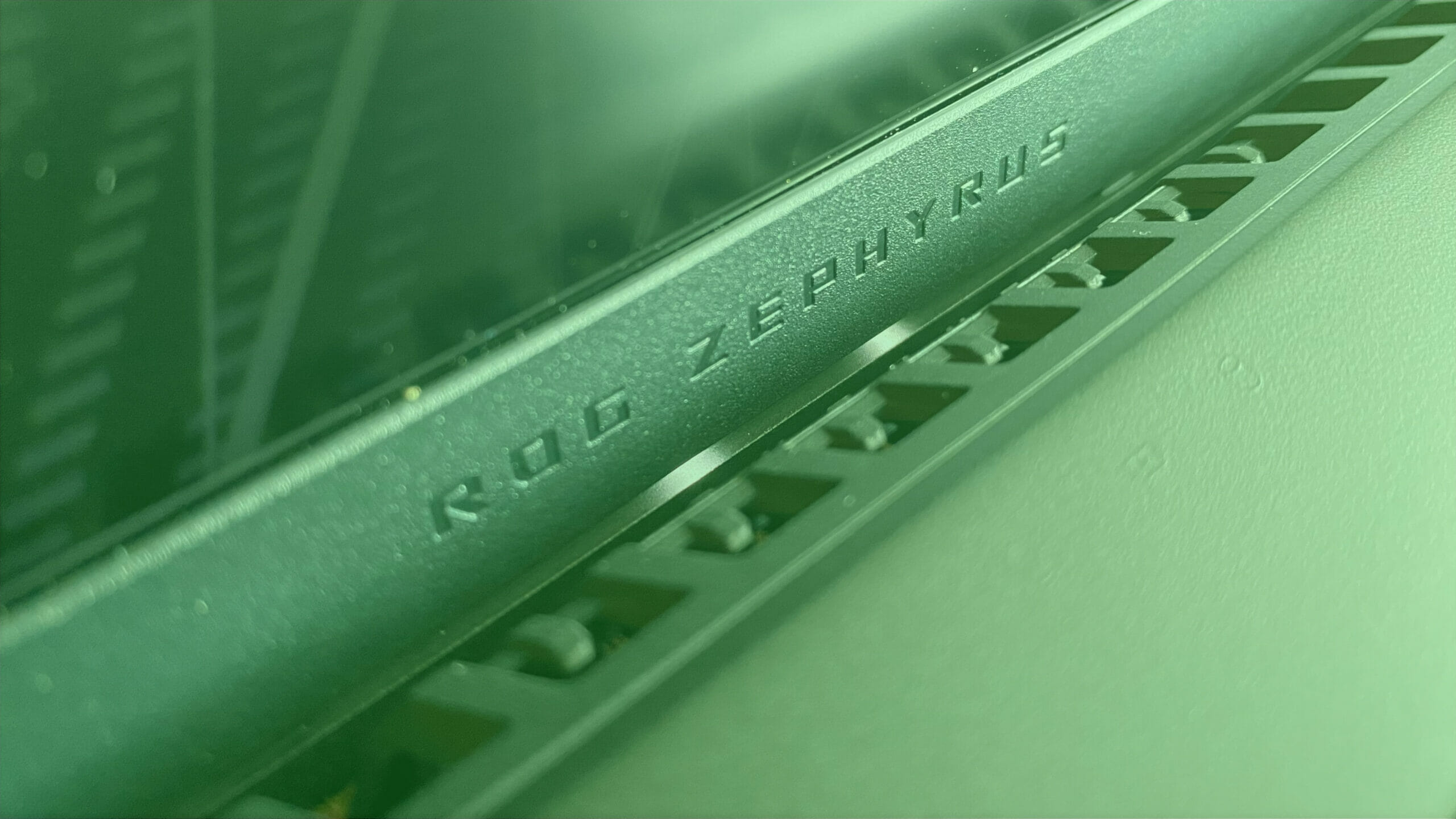Nvidia’s largest desktop-grade graphics cards continue to beckon the question of how, exactly, manufacturers are going to fit them into laptops? Would technological evolution commit to larger designs instead of thinning out with every iteration? Would stronger, and louder, cooling systems be required? What about the displays? Would brands have to sacrifice beautiful [and good] products in the name of raw horsepower? Turns out the answer is a resounding no, and the 2023 iteration of the ASUS ROG Zephyrus M16 absolutely proves how… but at what cost?

There are a few checkboxes a gaming laptop should absolutely check, and ASUS reviews generally hit most of them. Even so, there are times when manufacturer’s hit ‘home runs’ with a unique surprise release or two. The ASUS ROG Zephyrus M16 is one such example, featuring a flagship Nvidia graphics card, the latest Intel chipset, and a stunning screen – all jam-packed into the head-turning signature ASUS ROG design with its AniMe Matrix lid.
Out of the box, prospective users will be hard pressed to find much of a difference between the M16 and most of ASUS’s other gaming counterparts. It features a slim dark grey chassis with all of the signature ROG designs neatly in place. Like the ASUS ROG Zephyrus G14, the M16 has brought back the AniMe Matrix lid, only this time it seems more refined. Documentation on the exact make and model of the AniMe Matrix lid is scarce, but ASUS have either improved on the underlying LED network, or just outright changed the way it functions. It looks absolutely stellar in how smooth and gradual the AniMe Matrix design lights up with all of its gamey designs. As per usual, gamers who prefer their slimmer gaming laptops to be discreet still have the option to turn the LED backlighting of the lid off, which results in a lid that looks near-featureless.
When open, the ASUS ROG Zephyrus M16 features the same RGB-backlit keyboard as the G14. The keyboard is accompanied by a set of speakers, a massive touch pad, and four additional macro keys dedicated to the primary functions of the laptop’s proprietary features (such as turning the AniMe Matrix on or off, and boosting the fan speeds to max). When looking at it from the sides, users will notice massive grills and vents for heating, as well as a modest collection of inputs and outputs. These include a single Superspeed USB-A port, and a USB-C port capable of 20V/5A charging, as well as a MicroSD slot on the right-hand side; a USB-A port, and Thunderbolt 4 connector, as well as an HDMI 2.1 port capable of 4K/120Hz or 8K/60Hz gaming, a 3.5mm headphone jack, and a power socket on the left.

A noticeable omission in the ASUS ROG Zephyrus M16 is the lack of a Gigabit Ethernet port. In its stead, ASUS have implemented triple-band 802.11ax wireless connectivity, as well as Bluetooth 5.2. The laptop also comes with a serviceable 1080p webcam featuring Windows Hello capability. One thing to note is how Windows Hello via webcam is the only “convenient” secure option. Sadly, the ASUS ROG Zephyrus M16 does not feature a fingerprint reader or some kind of built-in USB-unlock featured in other laptops.
Thankfully, the ASUS ROG Zephyrus M16 is not a scrub when it comes to… pretty much any kind of performance. The Nvidia GeForce RTX 4090 Laptop chipset under the hood keeps gaming performance to the extremes with its 16 GB of VRAM, 76 RT cores, and 9,728 shader units. Together with the 4090, users can also expect to see massive clock speeds from the integrated thirteenth generation Intel Core i9-13900H and its six P-Cores, 5.4 GHz boost speeds, and eight E-cores. These processing units are also accompanied by 16 GB of dual-channel DDR5 memory modules, and a single 1 TB Samsung PM9A1 SSD.

In terms of performance, the ASUS ROG Zephyrus M16 managed to push virtually every game thrown at it, to its maximum settings. Assassin’s Creed Valhalla, for instance, hit an average of 90 frames per second, while Horizon Zero Dawn capped out at around 100 fps. Monster Hunter World, on the other hand, managed around 120 fps during most hunts. Forza Horizon 5 reaches highs of 110 fps but averaged around 90 fps. These results were captured using the laptop’s default “performance” mode as well. Meanwhile Marvel’s Spider-Man and Uncharted: Legacy of Thieves both averaged around 70 fps with Ray Tracing and Nvidia DLSS enabled, while running the laptop in its included “Turbo” mode (another one of the dedicated buttons mentioned above). Other modes include a “Windows mode”, which lets the laptop deliver balanced performance with a work-focused tweak underneath the hood, while “silent” mode keeps all of the fans on their slowest setting.
Much to my dismay, it needs to be said how these performance scores were all captured while plugged in. Unfortunately, the laptop simply does not have much of a foot to stand on compared to its G14 counterpart’s endurance. With the ASUS ROG Zephyrus M16 display cranked to around 75%, the laptop managed around two hours of game time on the standard “performance” mode. While doing nothing else but word processing and background YouTube streaming, the laptop managed around 4 hours of workload before it needed to be charged. Simply put, the sheer power of the internals do not allow for much portability in terms of gaming.

There is no denying how the ASUS ROG Zephyrus M16 is a powerful gaming laptop. It manages to pack flagship Nvidia graphics, the latest Intel chipset, and a stunning screen into a sexy dark grey chassis. With a modest collection of inputs and outputs, it still features top-notch technologies worthy of any new unit this side of 2023. It performs exceptionally well, and while it may not have all of the endurance one may ask for, it remains a beautiful and powerful gaming laptop checking all the boxes a gaming laptop should check. In short: it is a good laptop that will not disappoint gamers who are looking for top-performing hardware as long as they are content with keeping it wired.
Verdict:
GOOD
| PROS | CONS |
| Signature ROG design remains stellar | Battery life leaves a lot to be desired |
| Unparalleled mobile performance | No Gigabit Ethernet |
Device temporarily provided for review by ASUS Tek South Africa
Review Methodology | Ethics Policy
Junior Editor at Vamers. From Superman to Ironman; Bill Rizer to Sam Fisher and everything in-between, Edward loves it all. He is a Bachelor of Arts student and English Major specialising in Language and Literature. He is an avid writer and casual social networker with a flare for all things tech related.










